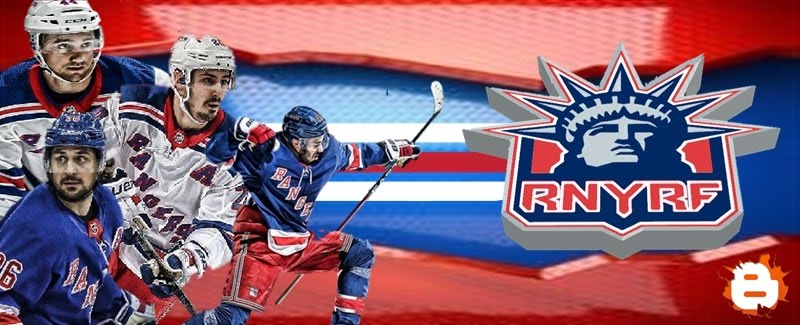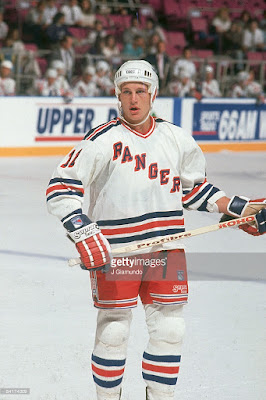NYR Alumni Birthdays September 3:
Cliff Barton LW (1939-1940) Doug Bentley LW (1953-1954) Jed Ortmeyer RW (2003-2007) Michal Rozsival D (2005-2007) Martin Stratka LW (2005-2007)
Today in NYR History 9/3:
1991: The Rangers sign free agent forward Adam Graves.
On Sept. 3, 1991, most of the hockey world was focused on an Ottawa arbitrator’s shocking decision to award All-Star defenseman Scott Stevens to the New Jersey Devils as compensation for Stevens’ former club, the St. Louis Blues, having signed Group 1 free agent forward Brendan Shanahan.
That very same day, however, the New York Rangers made a move that would help cement their future just as much as that arbitrator’s ruling did for the Devils. The club went out and signed a Group 1 free agent of their own, 23-year-old forward Adam Graves.
Adam Graves had to prove the skeptics wrong when he first arrived in New York as a free agent in September 1991.
The signing of Graves, who had scored only seven goals in 76 games the season before with the Edmonton Oilers, was, at first, overshadowed by the news of Stevens heading to New Jersey. When the Rangers and Oilers could not agree on compensation and an arbitration hearing date was set to resolve the dispute, the signing of Graves was openly questioned by many among the local media and fans.
Even after the arbitrator ruled in the Rangers’ favor -- awarding rugged winger Troy Mallette to the Oilers instead of Edmonton’s wish for forwards Steven Rice and Louie DeBrusk -- many people still questioned the wisdom of signing a player who had scored only 23 goals over the first 217 games of his NHL career.
Adding fuel to the fire was the fact that Mallette had become a very popular player with The Garden Faithful. Only 21 years-old at the time of the arbitrator’s ruling, Mallette had actually scored more goals (12) than Graves in the previous season, and he had netted 13 as a 19-year-old rookie two years earlier in 1989-90. Plus, Mallette was a stand-up teammate, who had racked up 305 and 252 penalty minutes in each of his first two seasons on Broadway, endearing himself to the home crowd with a wild fighting style that rocked The Garden.
However, Neil Smith, the Rangers’ general manager at the time, was confident that he had made the correct decision in signing Graves, who had a tremendous upside both as a player and a leader, at the expense of the often out-of-control Mallette.
Smith knew Graves quite well. When Graves was starring as a two-way power forward for the Windsor Spitfires in the Ontario Hockey League, Smith was watching his every move closely as the head of scouting for the Detroit Red Wings. After Graves scored 27 goals in his first season with Windsor, Smith and the Red Wings selected him 22nd overall in the 1986 NHL Entry Draft.
Graves responded with a 100-point season the following year at Windsor and by late in the 1987-88 regular season, the earnest, hard-working forward from Ontario had already made his NHL debut in Detroit.
However, two seasons later, after Smith had moved on to New York to become general manager of the Rangers, Graves was shipped to the Oilers as part of a trade that saw the high-scoring Jimmy Carson head to Detroit. That spring, playing on the so-called “Kid Line” with Joe Murphy and Martin Gelinas, Graves helped the Oilers capture their fifth Stanley Cup Championship, recording 11 points in 22 postseason games.
The big-game capabilities and passion for winning that would later become staples of Graves’ professional career began to emerge in the spring of 1990 during the Oilers’ run to the Cup. And Smith was not surprised at all, because he had seen these very same traits even when Graves was just a teen-ager playing in Windsor.
So when Graves became available through the controversial -- and short-lived -- Group 1 free agency loophole that prevented a player’s previous team from matching an offer sheet, Smith knew he had to find a way to bring him to New York, even with the dicey proposition that was arbitration to determine compensation.
And when local media outlets cried that the Rangers had surrendered Mallette for “a seven-goal scorer”, as The New York Times did, Smith was confident that over time the team would be vindicated for the signing.
It didn’t take long for Graves to show that the Rangers had made a wise move in signing him to a five-year contract. Offered the opportunity by head coach Roger Neilson to play as a top-six forward right from the outset of training camp, as opposed to the third and fourth-line duties he had logged with the Red Wings and Oilers, Graves began to flourish. And when Graves was placed on the left side of his former Oilers’ teammate Mark Messier upon The Captain’s arrival two games into the 1991-92 campaign, his game began to reach new heights.
Graves would go on to record 26 goals his first season in New York, helping the Rangers win the Presidents’ Trophy. He quickly won over Rangers’ fans everywhere with his intense play and willingness to stand up for his teammates, as well as for his goal-scoring and off-ice involvement in the community.
The rest, of course, is history, as the old cliché says. For 10 years Graves was the heart and soul of the Rangers, a leader on and off the ice as well as a star player. The mutual love affair between Graves and the fans at The Garden played out unabated whether he was scoring 52 goals and helping the Rangers win their first Stanley Cup in 54 years during the 1993-94 campaign or whether he was grinding through debilitating back pain trying with all his might to lead the Rangers back to the postseason when the new millennium arrived.
And it all started on an early September day in 1991, when so few could know that the Rangers had made, perhaps, the most important free-agent signing in franchise history.
1991: The Rangers trade Stephane Guerard to the Quebec Nordiques for Cash Considerations.




No comments:
Post a Comment